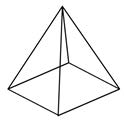Section 2.7: Working in Three Dimensions: Volume
Section 2.7 – Working in Three Dimensions: Volume
In the world of geometry, it is common to see three-dimensional figures. In mathematics, a flat side of a three-dimensional figure is called a face. Polyhedrons are shapes that have four or more faces, each one being a polygon. These include cubes, prisms, and pyramids. Sometimes you may even see single figures that are composites of two of these figures. Let’s take a look at some common polyhedrons.
Identifying Solids
The first set of solids contains rectangular bases. Have a look at the table below, which shows each figure in both solid and transparent form.
| Name | Definition | Solid Form | Transparent Form |
| Cube | A six-sided polyhedron that has congruent squares as faces. |
 |
 |
| Rectangular Prism | A polyhedron that has three pairs of congruent, rectangular, parallel faces. |
 |
 |
| Pyramid | A polyhedron with a polygonal base and a collection of triangular faces that meet at a point. |
 |
 |
| Cylinder | A solid figure with a pair of circular, parallel bases and a round, smooth face between them. |
 |
 |
| Cone | A solid figure with a single circular base and a round, smooth face that diminishes to a single point. |
 |
 |
| Sphere | A solid, round figure where every point on the surface is the same distance from the center. |
 |
 |
Volume
Recall that perimeter measures one dimension (length), and area measures two dimensions (length and width). To measure the amount of space a three-dimensional figure takes up, you use another measurement called volume.
Volume is measured in cubic units. A shoebox may be measured in cubic inches (usually represented as in3 or inches3), while the Great Pyramid of Egypt would be more appropriately measured in cubic meters (m3 or meters3).
| Name | Transparent Form | Volume Formula |
| Cube |  |
V = a · a · a = a3 a = the length of one side |
| Rectangular Prism |  |
V = l · w · h l = length |
| Pyramid |  |
V = [latex]\frac{l{\cdot}w{\cdot}h}{3}[/latex] l = length |
| Cylinder |  |
V = 𝝅𝒓𝟐𝒉 r = width |
| Cone |  |
V = [latex]\frac{{\pi}r^2~h}{3}[/latex] r = width |
| Sphere |  |
V = [latex]\frac{4}{3}[/latex]𝝅𝒓3 r = radius |
Content from text: College Mathematics, Second Edition
![]()
College Mathematics by Scottsdale Community College is licensed under a
Creative Commons Attribution-NonCommercial-ShareAlike 4.0 Unported License.
